A Novel Meander Bowtie-Shaped Antenna with Multi-Resonant and Rejection Bands for Modern 5G Communications
Abstract
1. Introduction
2. Proposed Antenna Design
3. Results and Discussion
4. Time-Domain Characteristics
5. Equivalent Circuit Analysis
6. Quad Port MIMO Antenna Analysis
7. Comparison with Related Works and Served Applications
8. Conclusions
Author Contributions
Funding
Data Availability Statement
Acknowledgments
Conflicts of Interest
References
- Wang, M.; Tang, M.; Zhang, H.C.; Xu, J.; Cui, T.J.; Mao, J. Miniaturization of Frequency-Reconfigurable Antenna Using Periodic Slow-Wave Structure. IEEE Trans. Antennas Propag. 2021, 69, 7889–7894. [Google Scholar] [CrossRef]
- Qwakneh, M.M.; AlHammami, K.A.; Omar, A.R.S.; Faouri, Y.S. Slot Antenna for Multi-Band Frequency Diversity. In Proceedings of the 2020 International Conference on Radar, Antenna, Microwave, Electronics, and Telecommunications (ICRAMET), Tangerang, Indonesia, 18–20 November 2020; pp. 287–290. [Google Scholar]
- Faouri, Y.S.; Sharif, H.; Smadi, L.; Jamleh, H.O. Low Pass and Quad Band Pass Tunable Filter Based on Stub Resonators Technique. Jordanian J. Comput. Inf. Technol. 2019, 5, 124–136. [Google Scholar] [CrossRef]
- Hassan, M.M.; Zahid, Z.; Khan, A.A.; Rashid, I.; Rauf, A.; Maqsood, M.; Bhatti, F.A. Two element MIMO antenna with frequency reconfigurable characteristics utilizing RF MEMS for 5G applications. J. Electromagn. Waves Appl. 2020, 34, 1210–1224. [Google Scholar] [CrossRef]
- Al-Hammami, K.A.; Omar, A.R.S.; Qwakneh, M.M.; Faouri, Y.S. Hexagonal Patch Shaped MIMO Antenna for Frequency Agility. In Proceedings of the 2020 IEEE International Conference on Communication, Networks and Satellite (Comnetsat), Batam, Indonesia, 17–18 December 2020; pp. 301–305. [Google Scholar]
- Omar, A.R.S.; Al-Hammami, K.A.; Qwakneh, M.M.; Faouri, Y.S. Frequency Reconfigurable Antenna Inspired by Tri-SRR Metamaterial. In Proceedings of the 2020 IEEE International Conference on Communication, Networks and Satellite (Comnetsat), Batam, Indonesia, 17–18 December 2020; pp. 296–300. [Google Scholar]
- Song, L.; Gao, W.; Chui, C.O.; Rahmat-Samii, Y. Wideband frequency reconfigurable patch antenna with switchable slots based on liquid metal and 3-D printed microfluidics. IEEE Trans. Antennas Propag. 2019, 67, 2886–2895. [Google Scholar] [CrossRef]
- Ahmad, S.; Ijaz, U.; Naseer, S.; Ghaffar, A.; Qasim, M.A.; Abrar, F.; Parchin, N.O.; See, C.H.; Abd-Alhameed, R. A Jug-Shaped CPW-Fed Ultra-Wideband Printed Monopole Antenna for Wireless Communications Networks. Appl. Sci. 2022, 12, 821. [Google Scholar] [CrossRef]
- Al-Gburi, A.J.A.; Ibrahim, I.B.M.; Zakaria, Z.; Ahmad, B.H.; Bin Shairi, N.A.; Zeain, M.Y. High Gain of UWB Planar Antenna Utilising FSS Reflector for UWB Applications. Comput. Mater. Contin. 2022, 70, 1419–1436. [Google Scholar] [CrossRef]
- Garbaruk, M. A Planar Four-Element UWB Antenna Array with Stripline Feeding Network. Electronics 2022, 11, 469. [Google Scholar] [CrossRef]
- Li, X.P.; Xu, G.; Ma, M.R.; Duan, C.J. UWB dual-band-notched lanky-leaf-shaped antenna with loaded half-square-like slots for communication system. Electronics 2021, 10, 1991. [Google Scholar] [CrossRef]
- Sharma, M.; Awasthi, Y.K.; Singh, H. Compact multiband planar monopole antenna for Bluetooth, LTE, and reconfigurable UWB applications including X-band and Ku-band wireless communications. Int. J. RF Microw. Comput.-Aided Eng. 2019, 29, e21668. [Google Scholar] [CrossRef]
- Sharma, N.; Bhatia, S.S. Performance enhancement of nested hexagonal ring-shaped compact multiband integrated wideband fractal antennas for wireless applications. Int. J. RF Microw. Comput. -Aided Eng. 2020, 30, e22079. [Google Scholar] [CrossRef]
- Al-Faouri, Y.S.; Awad, N.M.; Abdelazeez, M.K. Enhanced Ultra-Wide Band Hexagonal Patch Antenna. Jordanian J. Comput. Inf. Technol. 2018, 4, 150–158. [Google Scholar]
- Faouri, Y.S.; Awad, N.M.; Abdelazeez, M.K. Hexagonal patch antenna with triple band rejections. In Proceedings of the 2019 IEEE Jordan International Joint Conference on Electrical Engineering and Information Technology (JEEIT), Amman, Jordan, 9–11 April 2019; pp. 446–448. [Google Scholar]
- Yeboah-Akowuah, B.; Tchao, E.T.; Ur-Rehman, M.; Khan, M.M.; Ahmad, S. Study of a printed split-ring monopole for dual-spectrum communications. Heliyon 2021, 7, e07928. [Google Scholar] [CrossRef] [PubMed]
- Mansoul, A.; Seddiki, M.L. Multiband reconfigurable Bowtie slot antenna using switchable slot extensions for WiFi, WiMAX, and WLAN applications. Microw. Opt. Technol. Lett. 2018, 60, 413–418. [Google Scholar] [CrossRef]
- Qi, J.; Ren, J.; Qiu, J. A triple-band antenna based on bowtie and meander-line structures. In Proceedings of the 2017 IEEE International Symposium on Antennas and Propagation & USNC/URSI National Radio Science Meeting, San Diego, CA, USA, 9–14 July 2017; pp. 2479–2480. [Google Scholar]
- Elsadek, H.; Nashaat, D.M. Multiband and UWB V-shaped antenna configuration for wireless communications applications. IEEE Antennas Wirel. Propag. Lett. 2008, 7, 89–91. [Google Scholar] [CrossRef]
- Khan, Z.; Memon, M.H.; Rahman, S.U.; Sajjad, M.; Lin, F.; Sun, L. A single-fed multiband antenna for WLAN and 5G applications. Sensors 2020, 20, 6332. [Google Scholar] [CrossRef] [PubMed]
- Ullah, S.; Ahmad, S.; Khan, B.A.; Flint, J.A. A multi-band switchable antenna for Wi-Fi, 3G Advanced, WiMAX, and WLAN wireless applications. Int. J. Microw. Wirel. Technol. 2018, 10, 991–997. [Google Scholar] [CrossRef]
- Roshani, S.; Roshani, S. A compact coupler design using meandered line compact microstrip resonant cell (MLCMRC) and bended lines. Wirel. Netw. 2021, 27, 677–684. [Google Scholar] [CrossRef]
- Roshani, S. A Wilkinson power divider with harmonics suppression and size reduction using meandered compact microstrip resonating cells. Frequenz 2017, 71, 517–522. [Google Scholar] [CrossRef]
- Salim, A.; Baqaleb, S.; Faouri, Y. Multiband Meander UWB Bowtie Antenna with Six Rejection Bands. In Proceedings of the 11th International Conference on Information and Communication Systems (ICICS), Irbid, Jordan, 7–9 April 2020. [Google Scholar]
- Mighani, M.; Akbari, M. New UWB monopole planer antenna with dual band notched. Prog. Electromagn. Res. C 2014, 52, 153–162. [Google Scholar] [CrossRef][Green Version]
- Sanyal, R.; Sarkar, P.P.; Sarkar, S. Octagonal nut shaped monopole UWB antenna with sextuple band notched characteristics. AEU-Int. J. Electron. Commun. 2019, 110, 152833. [Google Scholar] [CrossRef]
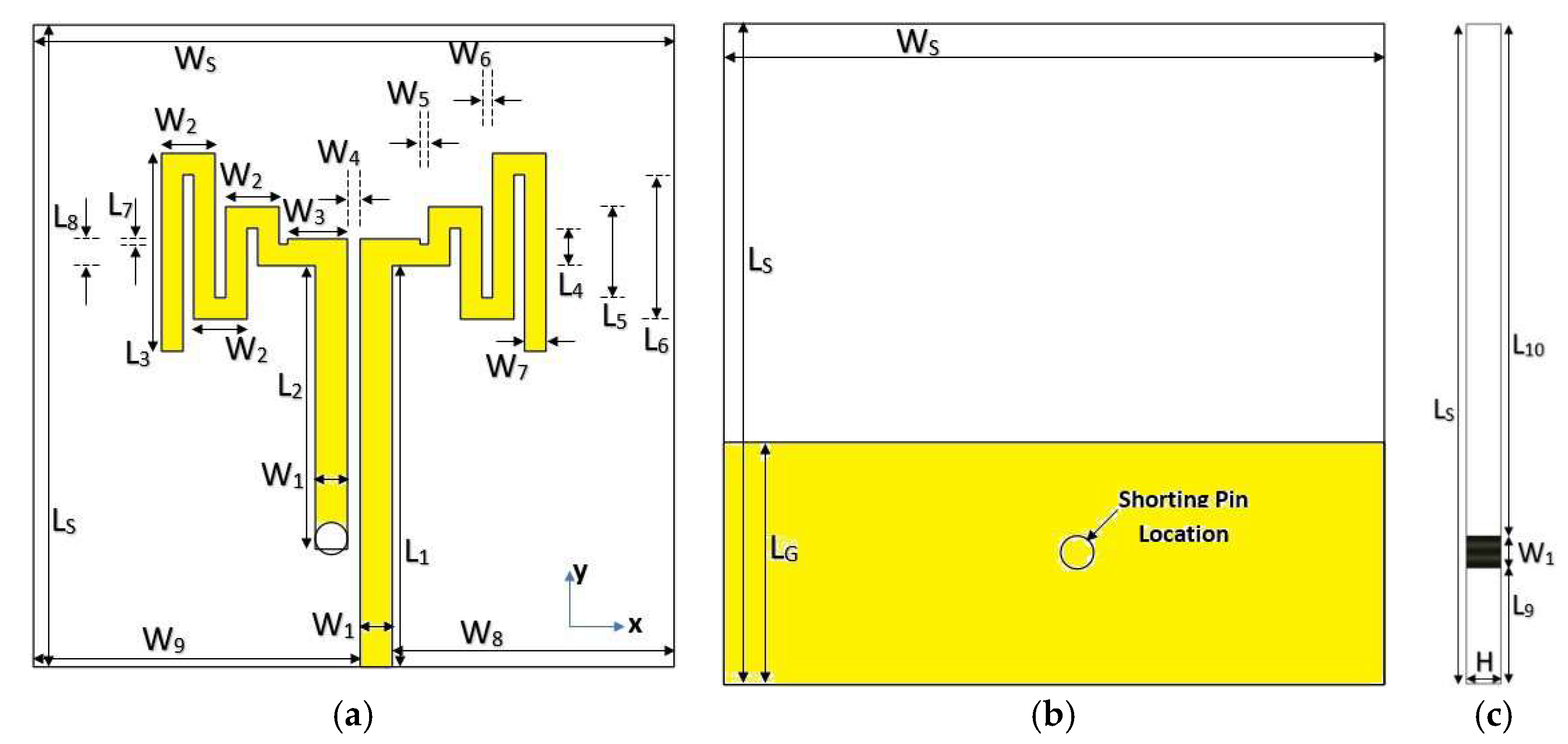






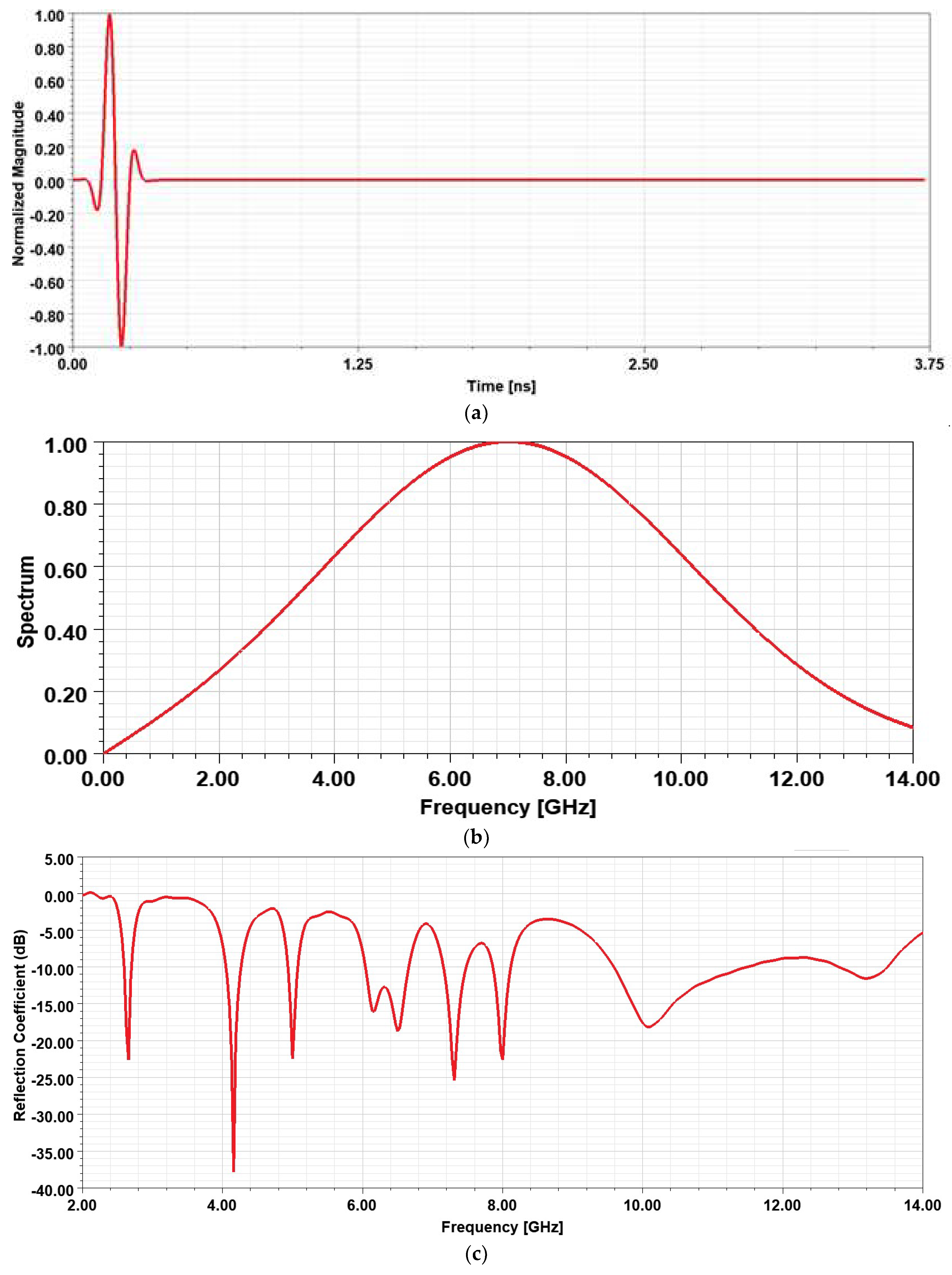

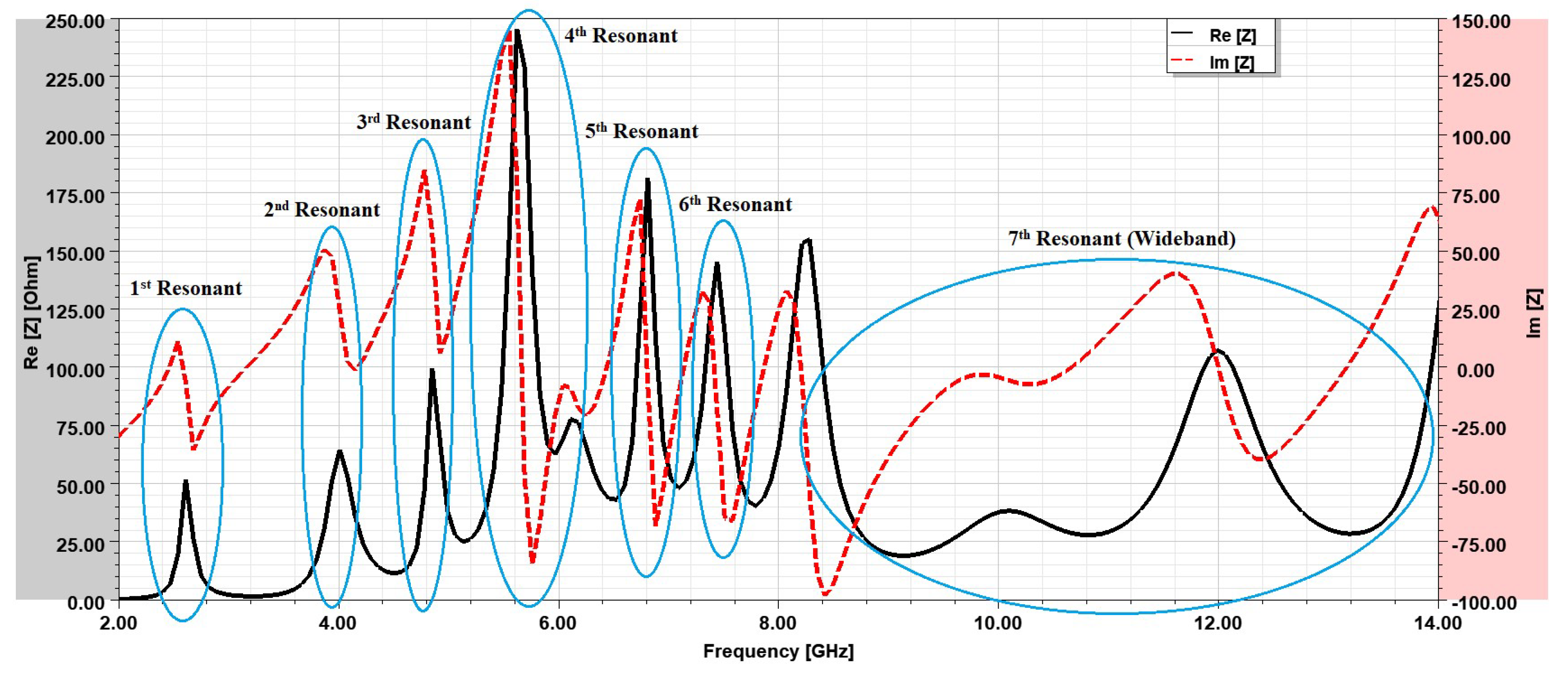




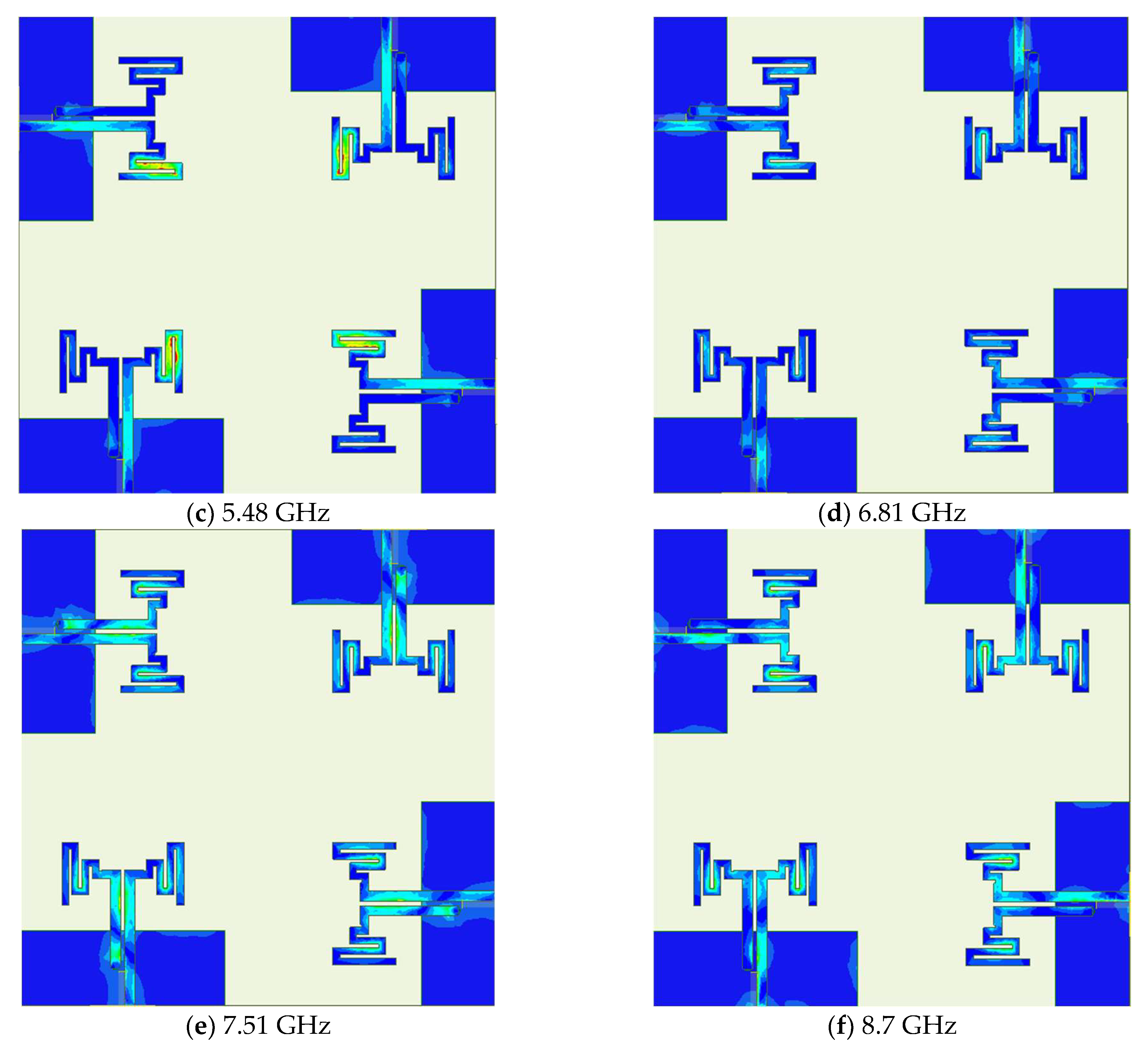
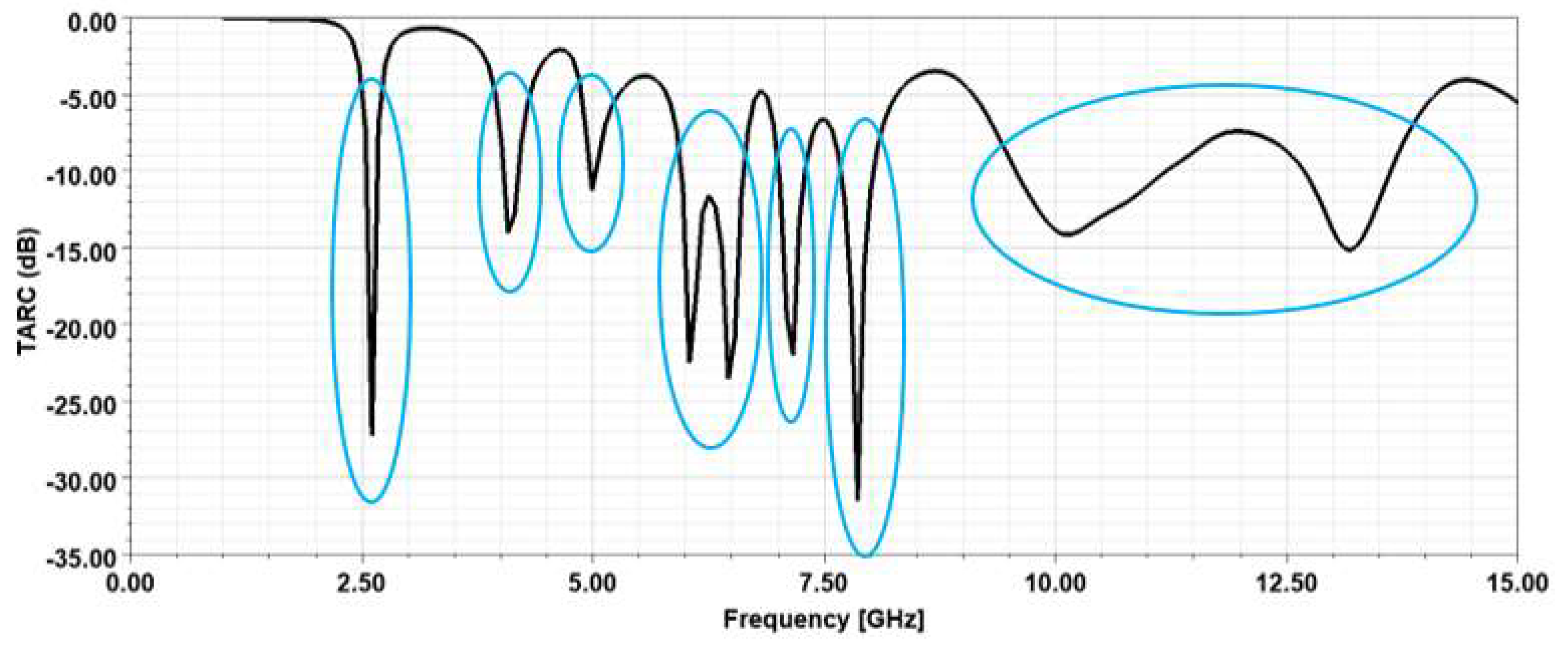
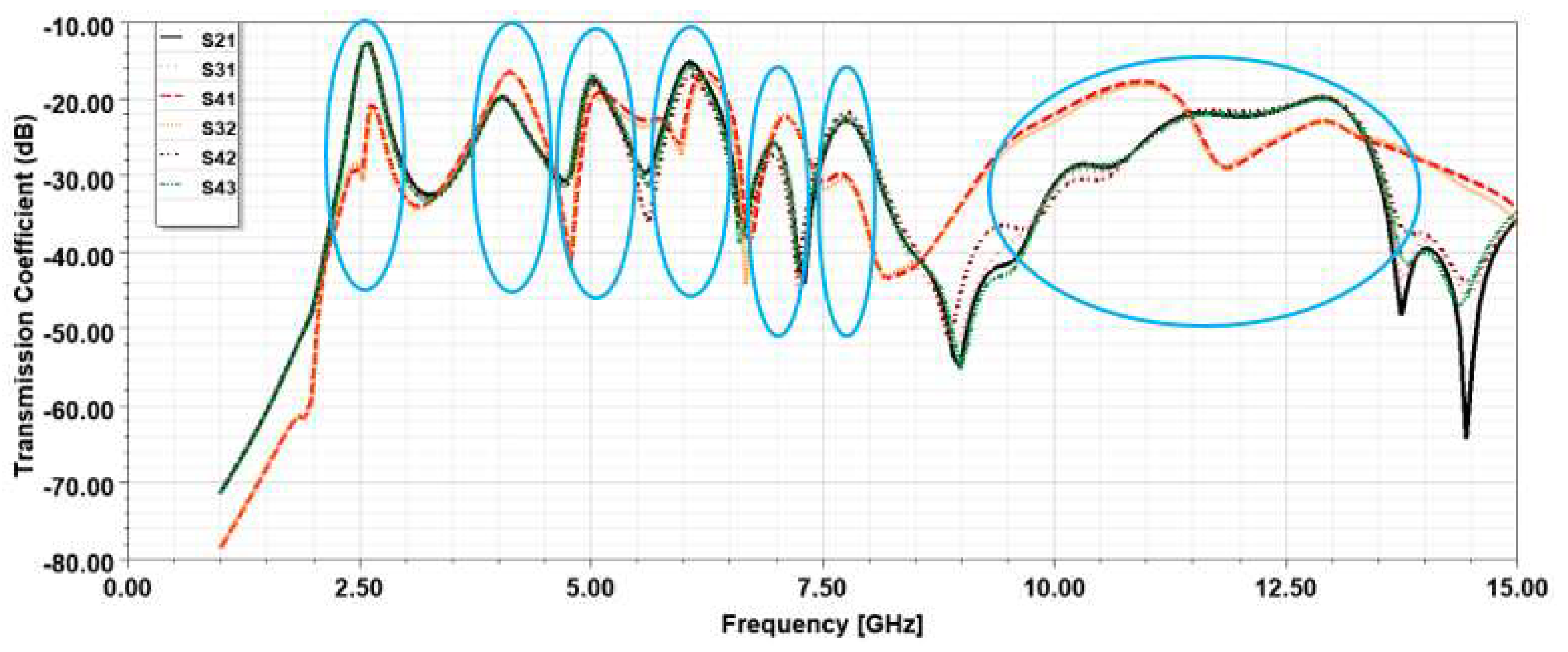
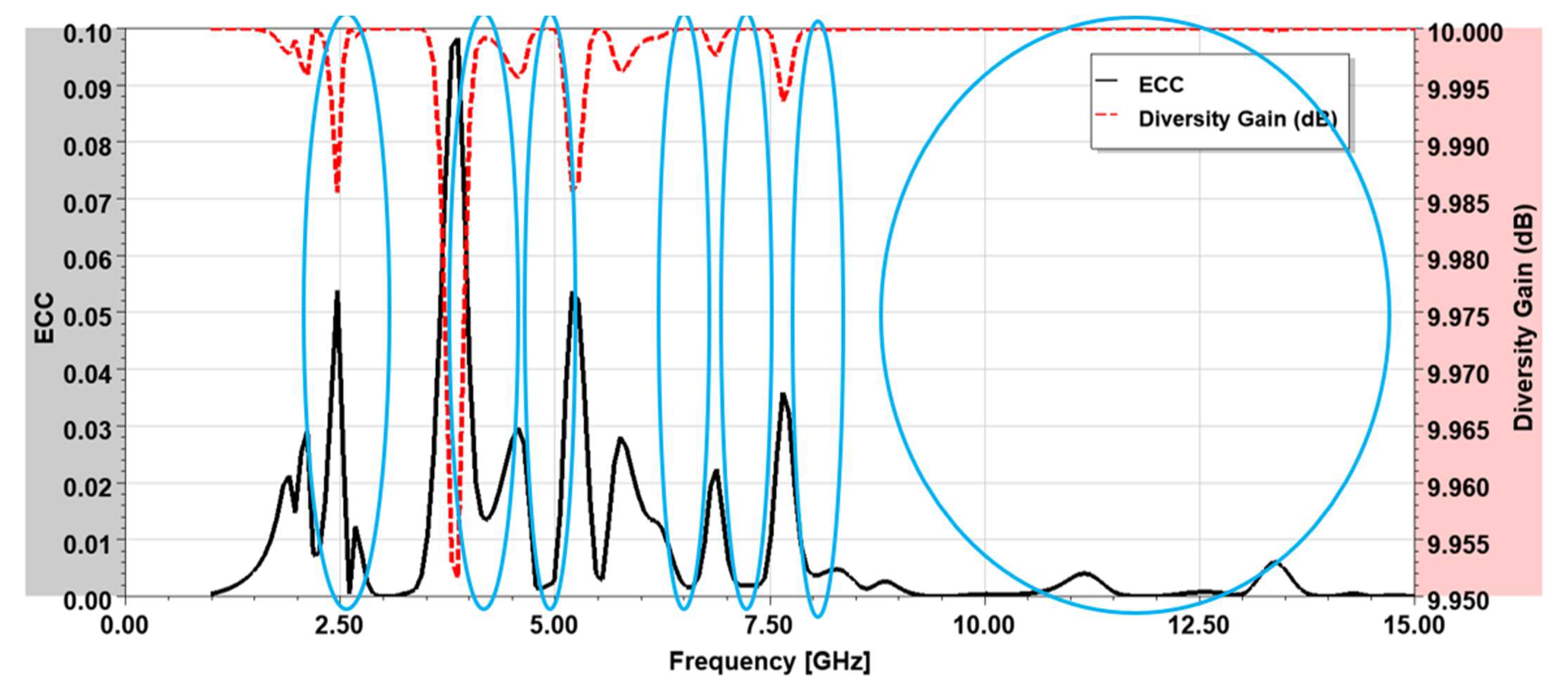
| Parameter | Value | Parameter | Value |
|---|---|---|---|
| WS | 30 | LS | 30 |
| LG | 11 | W1 | 1.5 |
| W2 | 2.5 | W3 | 2.8 |
| W4 | 0.6 | W5 | 0.4 |
| W6 | 0.5 | W7 | 1 |
| W8 | 13.2 | W9 | 15.3 |
| L1 | 18.75 | L2 | 13.25 |
| L3 | 9.25 | L4 | 1.75 |
| L5 | 4.25 | L6 | 6.75 |
| L7 | 0.25 | L8 | 1.25 |
| L9 | 5.25 | L10 | 23.25 |
| Notch No. | 10−dB BW (GHz) | fc | PBW % | Gain at fc |
| 1 | 2.88–3.93 | 3.1 | 33.87 | −6.35 |
| 2 | 4.15–4.88 | 4.64 | 15.73 | −0.69 |
| 3 | 5.23–5.88 | 5.55 | 11.71 | −1.20 |
| 4 | 6.44–6.97 | 6.95 | 7.63 | 0.70 |
| 5 | 7.29–7.82 | 7.58 | 6.99 | 1.07 |
| 6 | 8–9.08 | 8.84 | 12.22 | 0.98 |
| Measured Characteristics of the Proposed Antenna at the Resonances | ||||
| Band No. | 6−dB BW (GHz) | fr | PBW % | Gain atfr |
| 1 | 2.43–3.03 | 2.7 | 22.22 | 1.02 |
| 2 | 3.71–4.23 | 4.05 | 12.84 | 3.52 |
| 3 | 4.76–5.38 | 5.05 | 12.28 | 3.77 |
| 4 | 5.83–6.54 | 6.04 | 11.75 | 3.82 |
| 5 | 6.85–7.44 | 7.15 | 8.25 | 4.06 |
| 6 | 7.56–8.01 | 7.90 | 5.78 | 3.5 |
| 7 | 9.27–13.88 | 11.55 | 39.83 | 4.46 |
| Notch 1 | Notch 2 | Notch 3 | Notch 4 | Notch 5 | Notch 6 | |
|---|---|---|---|---|---|---|
| Q Simulated | 3 | 9.47 | 7.51 | 21.28 | 19.76 | 7.37 |
| Q Calculated | 4.53 | 6.92 | 9.33 | 11.17 | 18.5 | 3.55 |
| ROC Simulated | 7.68 | 11.32 | 8.09 | 12.43 | 9.71 | 4.11 |
| ROC Calculated | 8.1 | 8.23 | 10.45 | 7.25 | 8.57 | 1.12 |
| R1 = 28.81 | R2 = 37.43 | R3 = 55.52 | R4 = 120.53 | R5 = 27.31 | R6 = 114.96 |
| L1 = 3.80 | L2 = 31.96 | L3 = 47.75 | L4 = 5.52 | L5 = 40.02 | L6 = 147.98 |
| C1 = 0.14 | C2 = 0.095 | C3 = 0.031 | C4 = 0.052 | C5 = 0.022 | C6 = 0.033 |
| R7 = 3.38 k | R8 = 70.24 | R9 = 81.69 k | R10 = 9.21 k | Lf = 1.84 | |
| L7 = 902.61 | L8 = 34.62 | L9 = 26.96 | L10 = 1.09 m | R11 = 0.35 | |
| C7 = 1.98 | C8 = 0.018 | C9 = 1.98 μ | C10 = 0.18 | C11 = 0.58 |
| MEG 1 (dB) | MEG 2 (dB) | MEG 1/MEG 2 | CCL (bit/s/Hz) | |
|---|---|---|---|---|
| Resonant 1 | −3.57 | −3.52 | 0.99 | 0.38 |
| Resonant 2 | −3.09 | −3.12 | 1.01 | 0.06 |
| Resonant 3 | −3.22 | −3.21 | 1 | 0.14 |
| Resonant 4 | −3.27 | −3.27 | 1 | 0.18 |
| Resonant 5 | −3.07 | −3.03 | 0.99 | 0.03 |
| Resonant 6 | −3.05 | −3.05 | 1 | 0.03 |
| Resonant 7 | −3.15 | −3.16 | 1 | 0.09 |
| Ref. | Radiator Shape | Resonances (GHz) | Gain (dB) | Size (mm2) | No. of Spectrums | Covered Bands |
|---|---|---|---|---|---|---|
| [16] | Split Ring | 2.45, 5.2, 9.7 | 7 | 40 × 30 | 3 | S, C, X |
| [17] | Split Ring metamaterial | 4.27, 5.42, 12.4 | - | 20 × 20 | 3 | C, X |
| [18] | Bowtie and meandered lines | 1.62, 4.22, 7.13 | 8.2 | 20 × 10.4 | 3 | L, C |
| [19] | Triangle and V-parasitic | 2.88, 3.64, 3.95, 4.38, 4.81, 5.6 | 10.5 | 70 × 50 | 6 | S, C |
| [20] | Slotted conical patch | 2.4, 5.2, 5.8, 27.5 | 5.85 | 30 × 30 | 4 | S, C, Ka |
| [21] | F-shape element on a truncated ground plane | 2.1, 2.4, 3.35, 3.5, 5.28, 5.97 | 3.88 | 40 × 35 | 6 | S, C |
| Proposed Antenna | Meandered Bowtie | 2.7, 4.05, 5.05, 6.04, 7.15, 7.9, 11.55 | 4.46 | 30 × 30 | 7 | S, C, X |
Publisher’s Note: MDPI stays neutral with regard to jurisdictional claims in published maps and institutional affiliations. |
© 2022 by the authors. Licensee MDPI, Basel, Switzerland. This article is an open access article distributed under the terms and conditions of the Creative Commons Attribution (CC BY) license (https://creativecommons.org/licenses/by/4.0/).
Share and Cite
Faouri, Y.S.; Ahmad, S.; Parchin, N.O.; See, C.H.; Abd-Alhameed, R. A Novel Meander Bowtie-Shaped Antenna with Multi-Resonant and Rejection Bands for Modern 5G Communications. Electronics 2022, 11, 821. https://doi.org/10.3390/electronics11050821
Faouri YS, Ahmad S, Parchin NO, See CH, Abd-Alhameed R. A Novel Meander Bowtie-Shaped Antenna with Multi-Resonant and Rejection Bands for Modern 5G Communications. Electronics. 2022; 11(5):821. https://doi.org/10.3390/electronics11050821
Chicago/Turabian StyleFaouri, Yanal S., Sarosh Ahmad, Naser Ojaroudi Parchin, Chan Hwang See, and Raed Abd-Alhameed. 2022. "A Novel Meander Bowtie-Shaped Antenna with Multi-Resonant and Rejection Bands for Modern 5G Communications" Electronics 11, no. 5: 821. https://doi.org/10.3390/electronics11050821
APA StyleFaouri, Y. S., Ahmad, S., Parchin, N. O., See, C. H., & Abd-Alhameed, R. (2022). A Novel Meander Bowtie-Shaped Antenna with Multi-Resonant and Rejection Bands for Modern 5G Communications. Electronics, 11(5), 821. https://doi.org/10.3390/electronics11050821










